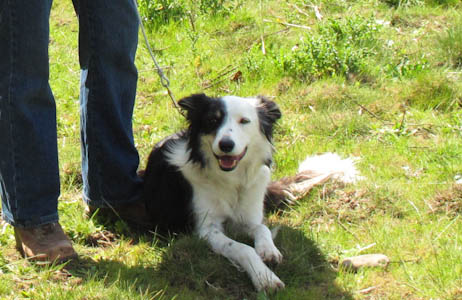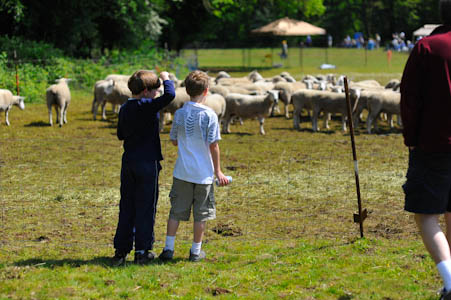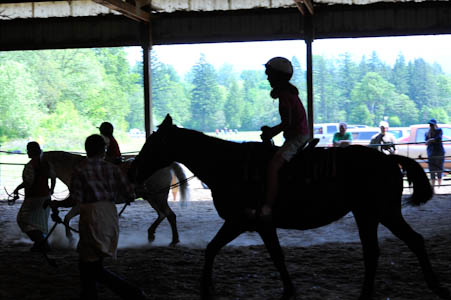SHEEP DOGS
“How about we go to the sheep dog trials in Scio?” Mom asked. My only other experience with sheep dogs had been high in the mountains north of our log cabin in McCall, Idaho. Bordering the largest wilderness area of the continental United States, Jim had hiked down a ridge and back two centuries in time. He stumbled upon hundreds of grazing sheep, a handful of sheep dogs and two friendly non-English-speaking Peruvian shepherds.
“Hola” yelled Jim, consuming much of his Spanish vocabulary. Eager for communication, Jim braved a question in Spanish. “How many years (años) did they have here?” Jim mastered the sentence structure, but mispronounced the word for years. Instead of years, Jim asked how many digestive sphincters they had. “Uno,” answered the Peruvians, each holding up one finger.

The next evening, Jim brought me up the hill in search of shepherds. While not fluent in Spanish, I speak enough to get into trouble, and Jim wanted to hear their stories. Alas, they’d moved camp. On our descent, we encountered sheep in the road and hopped from the car. Dogs announced our arrival and the shepherds approached, wearing smiles and old-world costume.
The Peruvians greeted Jim like a familiar friend, apparently forgiving his interest in their digestive tracts. They invited us into their sheep-herders tent and motioned for us to sit on a cot. Large bags of dog food lay in one corner and a stove shimmered liquid flames in another.
We learned about their families in Peru, how they earn enough to send money home for their children’s education. Here in Idaho they relocate every two or three days for fresh sheep grass; a rancher delivers supplies of food and coal for everyone else.
Tell us about the dogs, we asked. Their smiles faded as they recounted a recent tragedy involving a wolf and a favorite sheep dog. (I understood this much only because of an old rock band called Los Lobos, or “The Wolves.”) Somewhere in the telling, the shepherds’ painful tale surpassed my fluency, their words sailing beyond my comprehension. I showed appropriate concern, but my translation to Jim became, “I’m no longer tracking, but I think they’re sharing a dog massacre, so look sad.”
We shook hands and wished each other well.
BAD DOGS
The hamlet of Scio (pronounced SIGH-oh, population 695) lies 26 miles SE of Salem and 60 years in the past. The town that time never bothered tracking. Others have worse to say about Scio, a frequent object of mockery. The name alone invites ridicule. Scio is named for Scio, Ohio. That rhymes. Scio, Oregon doesn’t. Scio: All mispronunciation, not so much charm.
My mom fluttered with plans for a weekend visit involving two packs of young grandchildren plus their parents. What to do? Go to Scio, of course! Our family has lived in Salem for a half century, and none of us had ever been to Scio, not once. We’ve never met anyone who lived in Scio. People just don’t go there. The place is like Brigadoon. Was it safe to drop by? If we visited, would they let us leave?
Mom had heard about the sheep dog trials in Scio from an acquaintance. “International trials,” she boasted. What little grandchild wouldn’t love that? (From here on, I’ll refer to my nieces and nephews collectively. I do this to avoid outing individual naughtiness. I adore them all too much.)

On Scio’s main street, town-folk assembled lawn chairs in anticipation of the Lamb and Wool Festival Parade (this year’s theme: Diamonds R-4 Ewe.) We arrived before the parade, which consisted of farm implements. Think tractors, combines, hay balers, perhaps some manure spreaders. A rooster named Big Red guided the way.
Big Red had been an adored Scio mascot, patrolling a snack circuit of local businesses. Off-hours, he’d retire to his home in the feed-store warehouse. Big Red used proper crosswalks, had his own website, and captured national attention. One dreadful day a pit bull in a parked car spotted Red making his daily rounds. The dog jumped the car window and mauled Big Red. Big Red staggered to the door of the veterinarian, and collapsed.
The townspeople mourned Big Red, honoring him with a good stuffing. Red used to ride the parade in a gilded cage; now he heads the procession—his body mounted on the lead vehicle.
TOPDOGS
Perhaps because of the Scio’s sordid dog history, the sheep dog trials run well outside of town. Small brown signs with sheep outlines guided our way, signs we would have missed if not for the eyes of the four-year-old nephew. We paid entrance fees, parked, and negotiated deep ruts of dried mud. “Ankle-breakers,” my sister-in-law aptly described.
Down-rut, a pen corralled dozens of bored sheep; we stared back at them for a while. This is what we came for? Two nephews picked up rocks, lobbing them at the sheep. NOOOOO, we cried, grateful for the poor aim of our sheep terrorists.
An attractive young woman scurried over. “You can see better down there,” she urged in a German accent. (We later learned she ran the entire sheep show, her newly-acquired American passion.) We joined other spectators glued to the action some 100 meters up-field. “We watch from here so we don’t disturb the animals,” our German friend explained. “And we keep the sheep penned over there so they don’t get agitated before their trial.” Uh, oh.

I learned the basics of sheep dog trials, how the dogs guide handfuls of sheep around barriers, how they get points for accuracy, how they time the runs. More than I needed to know.
We didn’t last long at the sheep dog trials. Niece and nephews grew restless. Nephew barricaded himself in the lone Honey Bucket, the question of intent never resolved. My personal highlight was the dog gone rabid. Agitated sheep ran rampant through the course. The dog owner lay chase, screaming, blasting a whistle, likely cursing. His dog attained black-sheep status in the canine world that day. As I watched, I sensed a potential catastrophic connection to certain young rock-throwers.
Though feeling sheepish, we made a quick exit, letting sleeping sheep dogs lie.
CORNDOGS
After the sheep dog trials, we stopped at a nearby barn affixed with a sign advertising children’s horse rides. Why not, we thought. The nephews do so beautifully with farm animals.
A cowboy guided our riders through an hour of horse-play, assisted by hearty Mennonite girls sporting both jeans and skirts. The niece and nephews learned to stop, turn, reverse, gallop and complete other military exercises. I commented on the poise of our posse of pups. The cowboy responded, “You can’t really tell from here, but they’re real high off the ground. They sit still because they’re afraid of falling off.”
We returned to Scio hungry for fair food--any food, actually. Scio offered the feed store…and fair food. Annie and I shared some Chinese and ordered an elephant ear. Everyone else bought hotdogs and foot-long corndogs. I was confused. Normally my siblings monitor healthy food choices for their children in ways never considered by Jim and me. Next thing I knew, my brother slapped down an oozing “brick” of greasy fries for the kids to split.

Our elephant ear was so big that it required two large paper plates to carry. Plenty to share, I thought. Nephews yanked off large pieces of the cinnamon fried dough. “I need more,” they cried through full mouths, one hand grabbing, the other hand gripping a piece in reserve.
Afterwards I attempted to tidy up, brushing cinnamon sugar from the dirty picnic table onto my paper plates. Before I could stop him, a nephew sucked all the cinnamon sugar from one of the paper plates.
DOGHOUSE
The other day I dragged my dog-tired body from bed, pet our sometimes-good dog goodbye, and drove to Bush House Museum. I felt sick-as-a-dog but didn’t want to disappoint our director. Plus I was determined to uphold the dog-ma of a loyal museum tour guide.
Volunteering at Bush House regularly transports me to the Victorian era. I entered the well-preserved 1878 mansion, once the dog-friendly home of Sally Bush’s 26 cats and countless canines. In walked the new curator of one of our art galleries. She’d just returned from a trip to Scio to see her mother. She told me the rooster story and we laughed.
We chatted about Scio and about art. I told her I was sorry Jim couldn’t do another show with them because of their one-show policy. (This is what we’d been told.) Not true, she said. I want him to do another show, she said. A really big one, it turns out.
In the end, every dog and every artist gets his day--sometimes more with a new curator. What does this have to do with dogs? Without Scio’s sheep dog trials, Jim’s next art show probably wouldn’t be happening. We just may have to attend the Lamb and Wool Festival again next year.
-